The device and principle of operation of the siphon
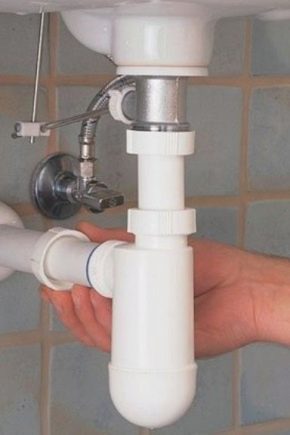
The siphon is an important element of drain fittings and is absolutely irreplaceable when installing sinks, bathtubs and shower cabins. The device is characterized by simplicity of design, low cost and wide consumer availability.
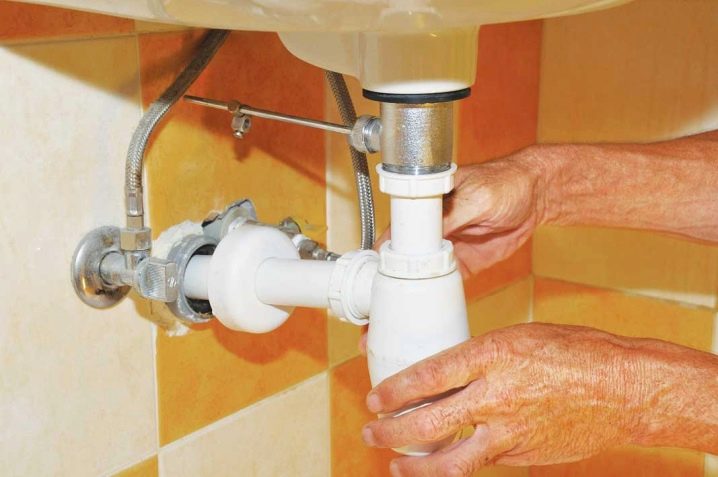
Features and purpose
The siphon is an independent sewer fitting designed to connect plumbing fixtures with a sewer system. In addition to plumbing, siphons are installed on the drains of washing machines and dishwashers, thereby preventing dirty deposits from entering the general network. Located between the household appliance drain and the sewer pipe, the siphon serves several important functions. It does not allow the spread of an unpleasant odor from the sewer lines, which is due to the presence of a water block or a water seal in it. The second, no less significant function of siphons is to prevent food debris and kitchen waste from entering the sewer line, accidentally ending up in the sink and washed away with water.
Thus, siphons act as a kind of double-sided filters that ensure the relative cleanliness of the sewer networks and protect the home from harmful odors. The siphons have a rather simple design and consist of a body, inlet and outlet sockets, rubber gaskets, a protective mesh for filtration, two outlet pipes, a connecting screw and seals. Some models are additionally equipped with an overflow system, which prevents the plumbing fixture from overfilling and splashing liquid over the edge, as well as additional outlets that allow you to simultaneously connect several devices at once, for example, a sink, a washing machine and a bathtub.
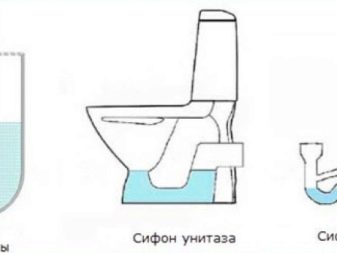

The principle of operation of the plumbing siphon is very simple and based on simple laws of physics.
- Water constantly accumulates in the lower or middle part of the device, which does not leave and maintains a constant pressure in the device. Thanks to this, unpleasant odors are blocked and do not rise into the room.
- Kitchen waste enters the siphon, settles on the bottom of the part of the device in which the water plug is located and remains there until the siphon is cleaned. Liquid drains freely pass through this compartment and are discharged through the outlet into the general sewer system.
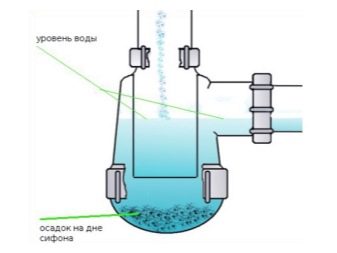
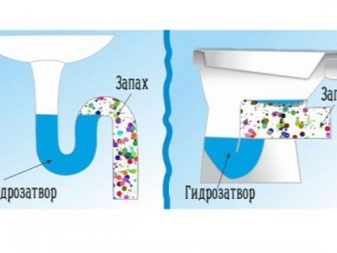
Siphons are classified according to several criteria, the main of which is the type of construction. According to this criterion, three types of devices are distinguished, a detailed description of which is presented below.
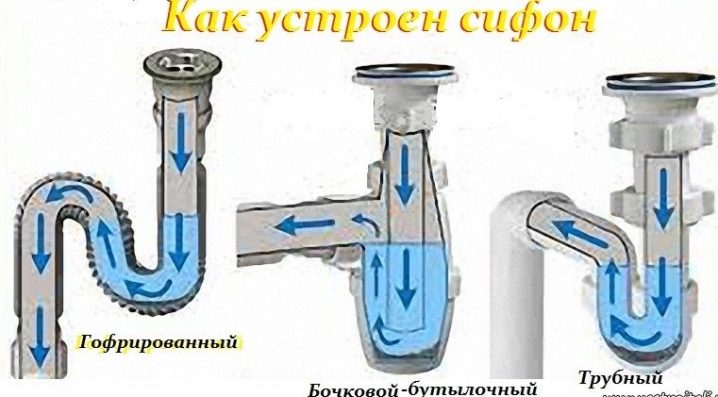
Bottle siphons
They represent the largest group of devices and are the most common and convenient. The fittings have a simple device and are installed without the invitation of a specialist. The design of the siphon consists of a cylindrical body, to the bottom of which a rounded flask-glass is screwed with a threaded connection. A short pipe is located inside the body, through which contaminated water from a sink or sink enters the flask. In the upper part of it there is an outgoing socket, connected by a threaded connection with a discharge pipe, which, in turn, is connected to a sewer pipe.
The bottle model looks like this: dirty water enters the siphon body through the drain hole of the sink, from there, through the upper hole, it goes into the branch pipe, through it - into the sewage system. At the same time, solid waste settles to the bottom of the flask-glass and does not enter the general drain system. It is in the flask that water accumulates and a water seal is formed, which does not allow sewer odors to enter the room.
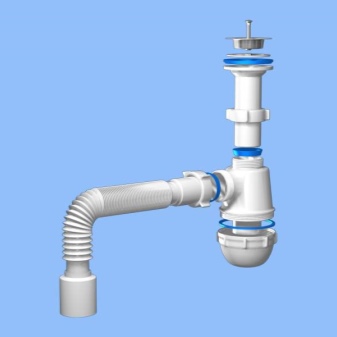
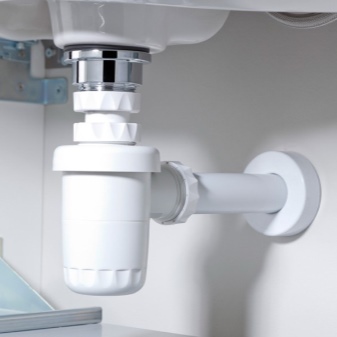
In order to remove waste from the siphon, unscrew the flask and shake out the debris that has accumulated there. It is also advisable to clean the cavity between the body and the short tube, it is also sometimes clogged with fat deposits and does not allow water to rise to the upper drain hole.
At the end of cleaning, the flask is screwed into place, water is turned on and the tightness of the connection is checked. The cleaning of the bottle siphon does not require any locksmith tools and is carried out entirely by hand. The role of a sealant for threaded connections of bottle siphons is performed by a coupling, which makes it possible to dispense with the use of gaskets and other materials necessary to form a tight connection. Thanks to this, even housewives can cope with cleaning such a model.


Corrugated siphons
Until recently, they were considered the most popular and were widely used when connecting sinks and washbasins. The device is presented in the form of a corrugated bent pipe made of soft materials and can easily change its shape. In section, the device is a zigzag-shaped hollow structure with threaded connections at its ends, with the help of which it is connected to plumbing and sewer pipe. The siphon installation process is simple and consists in the sequential execution of several steps.
First, a unit for draining water is attached to the sink drain, using for this the gaskets included in the siphon package. The lower end of the corrugated fitting is fixed in a tee that goes into the sewer pipe, and the upper end is connected to the drain pipe coming out of the sink. Next, the siphon is given the desired bend, which would ensure the formation of a water plug - a water seal.
It is recommended to make the bend more steep, otherwise it will not be possible to create the required pressure, and sewage odors will penetrate into the room.
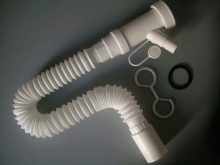
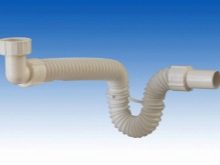
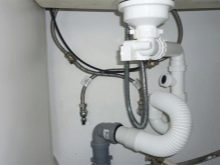
Pipe siphons
They are S- or U-shaped bent pipe and are compact in size. The fitting design includes the upper part, which is fixed to the bath (sink) with a special bolt, the middle working part of the curved shape and the lower - designed to connect the siphon to the sewer pipe. The assembly and installation of the devices is carried out using clamping nuts and O-rings. Fittings of this type are not recommended for installation in kitchens due to their tendency to quickly accumulate fatty deposits in a fixed knee. Disassembling and cleaning pipe models is a laborious and time-consuming process, which is why they are more often used for bathrooms.
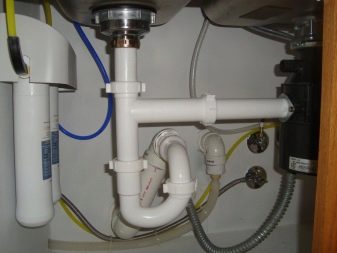

Flat siphons
Designed for installation under bathtubs and shower cabins and characterized by simplicity of design and miniature dimensions. Such devices consist of a flat case, on the upper side of which there are inlet and outlet openings. One of them is connected to a hose coming from the drain hole of the bath, and the second is connected to a branch pipe connected to the sewer pipe. The small height of the flat siphon is quite enough to create the effect of a water seal, but it is categorically not intended for the accumulation of food waste and solid debris. Therefore, it is not recommended to install flat models in the kitchen.


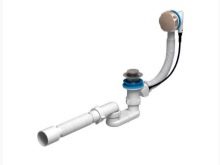
The next feature by which siphons are classified is the way the valve is closed. According to this criterion, manual and automatic models are distinguished.In the former, the valve is fixed on a chain, and the closing / opening of the drain hole is done manually. Siphons with an automatic valve are equipped with a system that is arranged and works as follows: a bottom valve located in the drain hole is connected by a series of movable rods to a control lever located on the water tap. When you press the lever, the valve opens and the water flows freely into the siphon and then into the sewage system. More expensive models come with a click-clack bottom valve and are equipped with an overflow system.
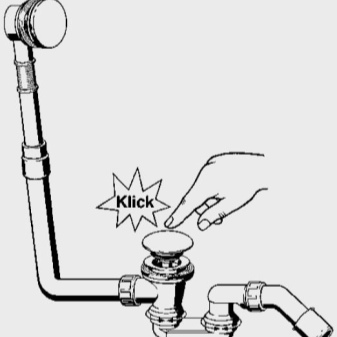
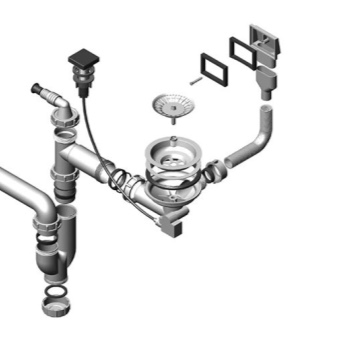
Criterias of choice
Before proceeding with the acquisition of a siphon, it is necessary to decide on the type of construction. So, if a model is chosen for a kitchen sink, then it is better to opt for a bottle-type appliance with a branch pipe diameter of at least 40 mm. This requirement is due to the fact that large volumes of water with a high content of fat and food residues pass through the kitchen siphon. This causes rapid clogging of the appliance and requires frequent cleaning. Therefore, the larger its inner diameter, the less often it will have to be unwound and cleaned.
If the siphon is chosen for a bath with short legs or a shower stall, then it is better to purchase a straight flat model. Such a device will perfectly fit into a narrow space and, despite its small dimensions, will create the desired water seal.
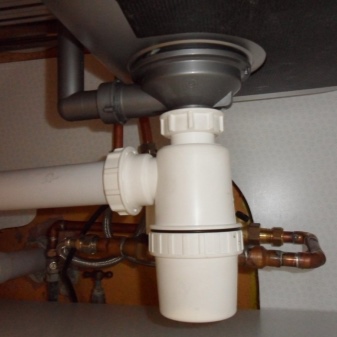
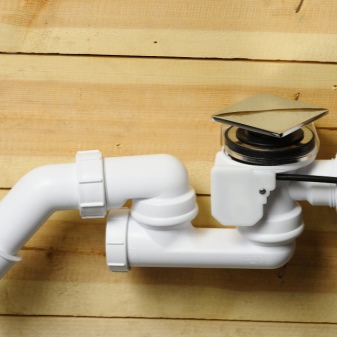
The next selection criterion is the siphon material. The most practical and reliable option are plastic models. They, as a rule, are equipped with the necessary set of gaskets and seals, have a simple structure and are mounted without the use of plumbing tools. Moreover, many plastic samples are equipped with additional pipes that allow you to connect several plumbing or household appliances to the siphon at once. But despite their high performance and long service life, plastic samples look rustic and often may not fit into modern kitchen or bathroom designs.
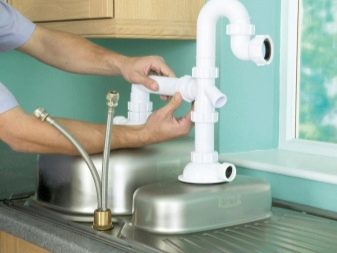
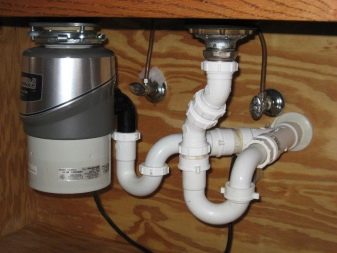
In this case, spectacular stainless steel models with a beautiful chrome finish and laconic forms will come to the rescue. Such siphons are mounted a little more complicated than plastic ones, however, they look much more stylish and noble. Brass models look no less attractive. They are also often nickel-plated and have a long service life. The advantage of metal models is an absolutely smooth inner surface that does not retain fat deposits and small debris.
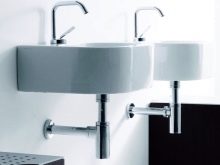


A competent choice, correct installation and timely maintenance of the siphon will ensure a long and trouble-free operation of plumbing fixtures and the entire sewer system.
For how the siphon works, see the next video.













The comment was sent successfully.